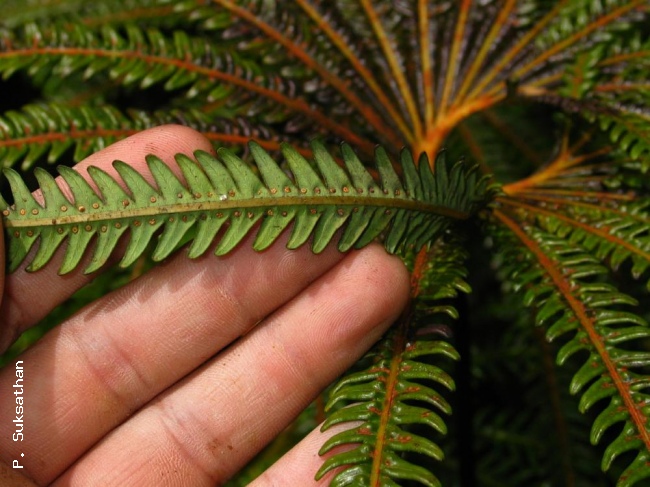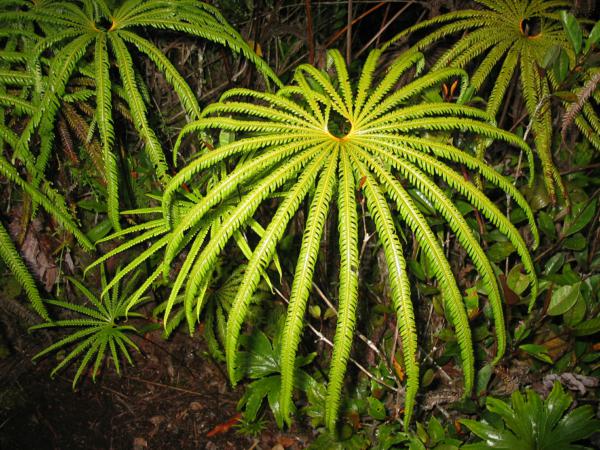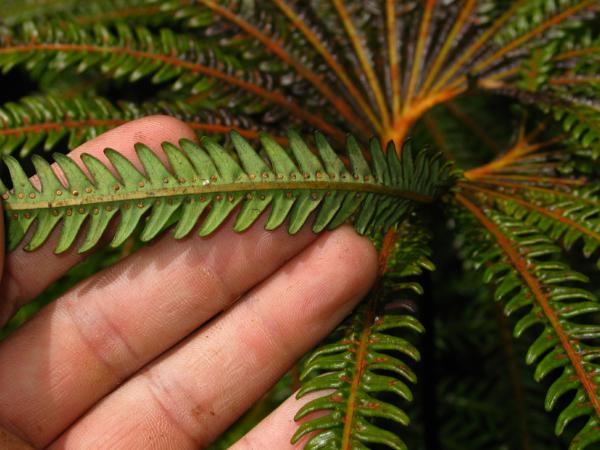
Matonia pectinata R.Br.
Family
Marsileaceae
Nomenclature
Matonia pectinata R.Br. in Wallich, Pl. Asiat. Rar. 1: 16, t. 16 (illustrations of the holotype). 1829; Hooker & Bauer, Gen. Fil.: t. 43 (illustrations of the holotype). 1840; Hooker, Sp. Fil.: 5: 285–286. 1864; Beddome, Ferns Brit. Ind. 2: 186, pl. 186. 1866; Beddome, Handb. Ferns. Brit. Ind.: 19 1883; Tansley & Lulham, Ann. Bot. (Oxford) 19(76): 475–519, pl. 31–33. 1905; Copeland, Sarawak Mus. J. 2(3): 388. 1917; Holttum, Rev. Fl. Malaya, ed. 1, 2: 59 & 60, f. 13. 1955 [‘1954’] (also 2: 59-60, 2nd edition, 1968); ; Kato, Blumea 38: 167–172. 1993; Kato, Fl. Males. Ser.2, Ferns and Fern Allies 3: 291. 1998; Lindsay et al., Thai For. Bull. (Bot.) 31: 47. 2004; Jaman, Fl. Pen. Malaysia, Ser. I, Ferns & Lycoph. 1: 104. 2010. – Type: Peninsular Malaysia, "Malacca, Mt. Ophir" (present day Gunung Ledang, Johor), near the summit at approximately 1200 m, 1815, Farquhar s.n. (holotype K-W, Wallich List no.184; iso CAL).
Description
Terrestrial. Rhizome creeping, dorsiventral, tricyclic-solenostelic, 4–6 mm in diameter and densely covered with shiny orange-brown hairs, 3–3.5 mm long. Fronds: alternate in two rows on the dorsal side of the rhizome, 1–2 cm apart. Stipe 40–85 cm long, 2–3 mm diam., brown or chestnut-brown, hairy at base but glabrous and shiny above, much longer than lamina. Lamina perpendicular to stipe (umbrella-like), pedate, symmetrical, consisting of a central pinna and, on each side of that, an equal number (5–12) of 10–24 progressively shorter pinnae, 20–45 cm diameter, central pinna 15–38 cm long; pinnae pectinate, deeply lobed, linear, coriaceous; costae glabrous on top, glabrous or hairy underneath; pinna segments linear-oblong and obtuse or narrowly deltoid and acute, usually oblique and falcate, up to 2 cm long and 4–6 mm broad at base, entire, with revolute margins, shiny on top, often glaucous and papillate underneath; veins forming costal areoles, forked, free or only weakly anastomosing in sterile portions of segments, always anastomosing in soriferous portions (sori centred on small circular veins fed by 5–9 radial veinlets). Sori: on the underside of fronds, round, usually 0–3 per segment (but occasionally 4 or 5), often distributed with a bias towards the basiscopic sides of segments; indusia hemispherical, peltate, deciduous, thick in central portion and membranous and inrolled in marginal portion; sporangia 5–8 in one layer arranged in a tight circle around a prominent, persistent, receptacle; capsules subglobose-polygonal with incomplete oblique annuli. Spores: tetrahedral-globose, trilete, pale, surface granulate .
Distribution in Thailand
PENINSULAR: Trang, Yala.
Wider Distribution
Peninsular Malaysia, Riau Archipelago, Lingga Archipelago and Sumatra.
Ecology
In Thailand grows only in exposed areas or in relatively open scrub on or near the tops of mountains at altitudes of 1200–1520 m.
Proposed IUCN Conservation Assessment
Least Concern (LC). Although collected only twice in Thailand this species is widespread in Malaysia and western Indonesia and not under any known threat.
Habit

Lower surface of pinna with sori
Site hosted by the Royal Botanic Garden Edinburgh. Content managed by Stuart Lindsay, Gardens by the Bay, Singapore and David Middleton, Singapore Botanic Gardens. Last updated 24 January 2012

